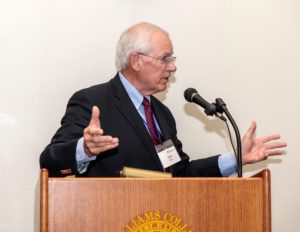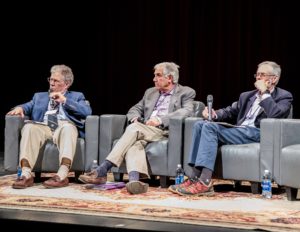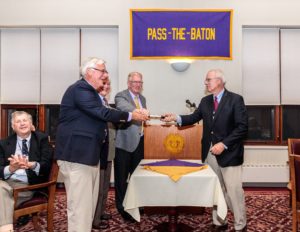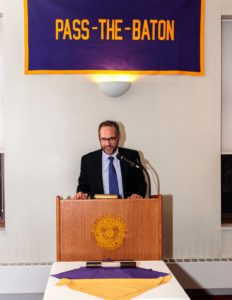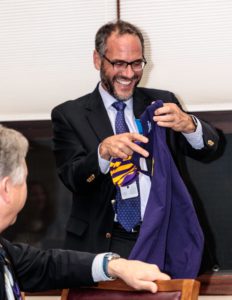Reconnect, Appreciate, and Celebrate was the theme for our 50th Reunion June 7-10, 2018. It could also have been the theme for our final Mini-Reunion in October 2017. 60 classmates, spouses and partners gathered to reconnect with each other, appreciate being back in the Purple Valley, and celebrate the past half-century.
Reconnect, Appreciate, and Celebrate
Here are a few recollections from a weekend filled with engaging events, meaningful meetings, thought-provoking lectures, and lively conversations.
RECONNECT
Reunion Planning Meeting
Barton Jones and Bob Stanton led a spirited discussion on every aspect of our 50th Reunion weekend, from music-to-dance-by to clothes-to-march-with to soup-to-nuts meal planning. Horn Hall, the first new Williams residence building in 40 years, will serve as ‘68 Reunion Headquarters. Its central location on Stetson Court (across Main Street from the Adams Memorial Theater / 62 Center for Theatre and Dance), its variety of conference rooms for large- and small-group discussions, and its private backyard for fun and games will bring a fresh approach to our fifty years of nostalgia.
Are you looking for a convenient and cost-effective place to stay during Reunion? Horn Hall dormitory rooms include 10 double rooms and 40 single rooms, all clustered in suites of six (i.e. six singles, or a double and four singles). The price is unbeatable: $80.00/person total for the entire reunion!
Class President Ned Perry and his leadership team designed every event in the past five years—from regional dinners to mini-reunions to the ’68 Oxford odyssey—to be welcoming and inclusive. To continue that goal at the 50th, Pattie Dirlam and Arleen Heiss presented the results of their research about the types of experiences suggested by spouses and partners to assure that June 7-10, 2018 will be “not just for the ’68 guys.”
Advances in Medicine Panel
Why include this panel under our “Reconnect” theme? Even though the discussion was open to all attendees from all Mini-Reunion classes, each of the physician presenters was from ’68. It was stunning to realize that the Pat O’Grady, Michael Yogman, and Mark Donavan we remember from as mid-sixties students had become a brilliant cardiologist, brilliant pediatrician, and brilliant primary care / oncologist / hospital administrator, respectively. The following concepts from each ‘68 panelist give a feel for their riveting presentations:
Moderator Pat O’Grady: In the past, a cardiologist would prescribe bed rest and pain medication and allow the heart injury to heal. Catheterization created a major change, from the early balloon with a crimped metal cage to drug-coated stents that reduce scarring. From the era of spending many days in the hospital after heart surgery, today it may take from 60 to 90 minutes to transfer a heart attack patient from the ER to a completed angioplasty, with the patient discharged home in a few days.
The future will see genomics correcting many conditions, and artificial intelligence performing a consultative role to synthesize and access voluminous amounts of research data.
Michael Yogman: Years ago, vaccines helped wipe out childhood diseases. We’ve seen major advances in curing or reducing childhood malignancies, heart problems, early deaths from premature birth and cystic fibrosis. Today and tomorrow, we need to focus on the social determinants of health, i.e., housing, adequate food, safe neighborhoods. In most western industrialized countries, 70% of dollars are focused on tackling the social causes of poor health and 30% are focused on medical solutions; in the United States, 70% of the dollars are focused on medical and 30% on social causes, with worse outcomes.
Given parents’ exposure to television advertising and other influencers, they often expect a pediatrician to prescribe a drug to cure a medical problem. We need to tell them that the most effective cure may be, for example, exercise and healthy nutrition. The current crisis in health care is the skyrocketing cost. New research on primary prevention in early childhood shows great promise for influencing the brain, genome, the immune system and the inflammatory system, reducing mental health problems and costly chronic diseases such as heart disease, diabetes and stroke.
Mark Donavan: Mark shared his startling personal look at Bennington Hospital, as it transformed from having a non-staffed emergency room with three cots in 1966 into an increasingly modern facility over the decades. He reminded us that in 1966, healthcare represented 5% of our country’s GDP. By 1978, that expenditure had risen to 8%. By 2017, health care had climbed to 18% of our GDP. His conclusion: Healthcare is the Achilles heel of our country’s future.
The Football Game
It was sunny and warm, a great place to connect after the Tailgate luncheon under the tent.
Tufts 21. Williams 13.
Next time!
APPRECIATE: Leadership
Conversation with Don Kjelleren, Director of the Williams Career Center
‘68’s Reunion Fund is focused on two priorities: Increasing the Class of 1968 Scholarship Fund and Transforming the Williams College Career Center. It’s clear that the Career Center transformation has already begun. Don Kjelleren began his presentation by outlining the evolution of career services in higher education:
1900-1920 Vocational Guidance
1920-1940 Teachers Guidance
1940-1970 Job Placement
1970-1990 Career Counseling
1990-2010 Professional Networking
2010-2030 Connections and Communities
He outlined the new vision of the Williams Career Center:
- Engage with students during all four years
- Help students develop real-world skills
- Draw upon alumni, parents, faculty, and staff
- Build lifelong connections among networked alumni
After reviewing his team’s successes during Don’s first year at the helm, he described the themes for 2017-2018 progress:
- Access and Inclusion
- Transformative Technology
- Programmatic Innovation
- Smart Staffing
- Renovated Space
As Don explained each of these broad categories in depth, it is clear that the Class of 1968 “backed the right horse.” The enhancement of the Career Center, well underway, deserves our Class Gift to keep the momentum going.
APPRECIATE: Students
Reunion Fund Committee
The RFC and students? Eye-opening presentations early Saturday morning by Williams students Justin Cho ’18 and Melinda Kan-Dapaah ‘20 reminded committee members why our classmates are so passionate about donating to Williams. Justin, from the state of Washington, and Melinda, from Ghana, participated in the Career Center’s summer internship program, in two opportunities funded by the Class of ’68.
Justin interned at Pacific Bridge Medical in Bethesda, Maryland, a provider of business development and regulatory consulting services for Asian medical markets. Melinda returned to her native country’s Institute of Economic Affairs, where she worked on affirmative action for women in Ghana’s Parliament. Both students were articulate, motivated, candid and inspiring.
After heartfelt applause, the committee turned to the status of the ‘68 Reunion Fund and progress toward our two Class Gift priorities. RFC co-chair John Oppenheimer reported impressive progress in total gift commitments through October, but we still have a ways to go to increase the percent participation. Oppy reinforced that all gifts of any amount are welcome, and that gifts can be made to any approved Williams priority. In the months leading up to our 50th, gifts and pledges that are unrestricted, commitments dedicated to the Class of 1968 Scholarship Fund, and commitments focused on Transforming the Williams Career Center will be especially important.
For more information on this website about giving to our 50th, just click on “Giving” in the footer to go directly to that section.
APPRECIATE: Faculty
Confident, Convincing, and Completely Mistaken: The Psychology of Eyewitness Misidentification, Laura Smalarz, Assistant Professor of Psychology
How many times have you seen a police lineup on TV? Maybe some of our classmates have seen one in real life. With luck, none of us have been in one as the “perp.” Professor Smalarz shared disturbing research, made real with interactive audience exercises, that pointed out flaws in our memory mechanism. Chilling specifics convinced the audience how incredibly wrong memory can be when a witness points out, with “confidence,” an alleged perpetrator.
Professor Smalarz contrasted the widely accepted (but woefully inadequate) analogy of human memory as a video camera: simply access the “disk” in the mind and playback the memory. A more current and cogent view is the “trace evidence” analogy—witnessing an incident will leave trace evidence in the brain, subject to contamination and distortion.
One of the most significant factors that can increase the witnesses’ confidence to testify occurs right after they choose the lineup person whom the case detective believes committed the crime. A subtle smile from that detective, or even a documented comment such as “Yup, you picked the guy we thought did it” has sent the wrong person in jail for years. Even though a 2014 National Academy of Sciences recommended that all police lineups should be “double-blind” (i.e., the person who administers the line-up should have no knowledge of the people chosen for that line-up)…in the United States, only 31% of lineups are double-blind, while 69% continue to be standard lineups.
Mini-Reunion participants also enjoyed the Faculty Lecture: Making Buildings Smarter: Using Technology to Achieve a More Sustainable Future, presented by Jeanie Albrecht, Professor and Chair of Computer Science. A hands-on group worked with Antonia Foias, Chair and Professor of Anthropology, and her students at the Williams College Museum of Art in an Object Lab, The Seeds of Divinity: Exploring Pre-Columbian Art & Civilization.
CELEBRATE
Outreach Committee Meeting
Outreach co-chairs Clint Wilkins and Bill Untereker reported that 195 of our class’s 271 living classmates have been contacted by their house representatives or other class volunteers with one message: Join us at the 50th to Reconnect, Appreciate, and Celebrate! As of October 2017, 138 classmates have committed to return to Williamstown in June 2018. The committee (whose sole function is fun-raising, not fund-raising) plans to continue their conversations with our classmates in the months ahead.
Pass-the-Baton Dinner
Yes, there really was a baton at the final banquet. ’67 Class President John Hufnagel gave a speech full of advice on how to have a fun 50th and offered sincere best wishes to ’68 as we approach that milestone. ’68 Class President Ned Perry responded with gifts for the ’67 leadership team and Williams 50th Reunion staffers Mark Robertson, Chris Robare, and Darlene Alderman. Ned added several classmates to the engraved Class of ’68 Spirit Bowl he’s dutifully and enthusiastically brought to every event in the past five years.
President Adam Falk addressed the ’67 and ’68 participants with a poignant note that this dinner would be his last official Alumni event before he leaves Williams to lead the Alfred P. Sloan Foundation. Adam has enjoyed getting to know alumni from every class, but what will he miss the most about Williams? “The students. I’ve been around students my entire life.”
To be sure that Adam would remember the unique Class of ’68, Ned awarded him a pair of purple and gold striped athletic socks, urging him to wear them when he runs the New York City Marathon so we could all cheer him on. Ned thanked President Falk for his service to Williams, and cheered him on in his new leadership venture.
Here’s the best way to sum up our final mini-reunion, and the best way to anticipate our 50th Reunion: Reconnect, Appreciate, and Celebrate!

